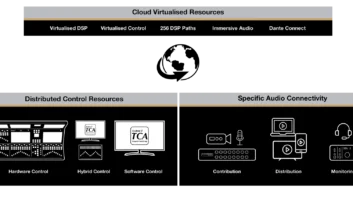Emerging from the fog of the pandemic it is time to seek some clarity about the future direction of our industry. Certainly, any doubts about cloud’s suitability for live production should now have been swept away. Distributed workflows powered by cloud processing and internet connectivity kept live events – and many broadcasters and producers – in business these past couple of years.
So much so that it is increasingly difficult to justify a return to traditional methods and carry on amortising expensive hardware. The return to the new normal marks the end of the road for conventional outside broadcast workflows but this will not happen overnight.
The reality, in the short term at least, is that broadcast is likely to deploy hybrid systems, still leaning on traditional tools but incorporating new software, IP and cloud elements.
The agile streamlined option
The reasons for shifting production, contribution and distribution architectures to cloud are overwhelming. Cloud technology has proven to be flexible, scalable, and battle-hardened with its enforced global use from March 2020 shaving years off the timing of its inevitable introduction. Both the cost and limitations of legacy systems will eventually prove to be too restrictive, especially when resolving the economic impact of Covid-19.
It’s not as if broadcasters were deluged with complaints about the quality of production delivered under remote and sometimes even remote-from-home conditions. Cloud offers localisation, personalisation, and interactivity which traditional systems have no means of matching. In parallel to that, sports fans are increasingly migrating to streaming services and online viewing, which offers the opportunity to deliver the advanced digital features not available in traditional productions.
The expected production values for live sport using cloud systems are often just as high as productions using conventional OB gear. Singular.live, for instance, provides Intelligent Overlays – live custom graphics integrated with rich data to enhance presentation for all Scottish Professional Football League matches in conjunction with the league’s production partners QTV and RCS. Matchday teams are using Singular.live to create and control all the broadcast graphics in the cloud.
Not all clouds are the same
So far, I’ve used the term ‘cloud’ broadly but if the industry is to truly evolve then it must learn to differentiate vendor technologies and the claims made for cloud.
One popular version of cloud is’ virtualised’ or ‘remote surface’ production’ using cloud-based tools. These solutions are indeed superior to traditional OB technology since they slash shipping and transportation requirements of kit and crew. However, they are not cloud in its true sense. They still require dedicated hardware – it is simply stored somewhere and controlled remotely over the internet.
Cloud native solutions, however, do not use or require dedicated hardware. This is the only way the industry can unlock the real benefits of cloud – namely scalability, flexibility, and – crucially – sustainability.
Simply moving to cloud is not good enough. A recent IBC Innovation Accelerator project on sustainable live production put cloud forward as a potential way of easing the environmental impact of live production. As a leading participant in this along with BT Sport, Sky, Microsoft and the Premier League, we realised that there is still lingering confusion within the industry over what cloud is. Cloud production reduces the amount of technical infrastructure required for the gallery production, for some broadcasters up to 70 per cent and that is compared to a remote production.
For example, it is still not clear to what extent cloud services can reduce the environmental impact of live productions. This uncertainty stems from the fact that the industry has not properly defined what cloud means. As we continue to learn more about what we mean by cloud and in particular cloud-native we will be better informed as to how we can realise the benefits that can be gained.
Collective action on climate
Even as an entirely digital cloud native solution we can’t quantify the carbon savings that the use of our platform would make compared to buying dedicated graphics hardware and shipping it around the world, let alone a system that is cloud-based.
Sky, the BBC and BT Sport identify the same issue. It’s because it is incredibly difficult to trace and measure the total resource usage of cloud providers, which often use a mixed power supply infrastructure that harnesses various different sources of energy. As a result of initiatives like the Accelerators, cloud providers are fully cognisant of the demands being laid down by broadcasters and are actively engaging with the industry to collaborate on this.
We applaud them for that and urge everyone to go deeper in working with initiatives like albert to ask hard questions about how environmentally friendly their cloud platform is.
Cloud native solutions are essential to achieving effective remote working, global collaboration and to driving more sustainable working practices. If the solution is not cloud native it is just a stop gap to the inevitable future.






